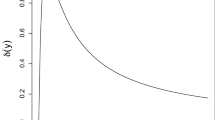Abstract
This paper addresses model selection using information criteria for binary latent class (LC) models. A Monte Carlo study sets an experimental design to compare the performance of different information criteria for this model, some compared for the first time. Furthermore, the level of separation of latent classes is controlled using a new procedure. The results show that AIC3 (Akaike information criterion with 3 as penalizing factor) has a balanced performance for binary LC models.
Access this chapter
Tax calculation will be finalised at checkout
Purchases are for personal use only
Preview
Unable to display preview. Download preview PDF.
Similar content being viewed by others
References
AKAIKE, H. (1974): A New Look at Statistical Model Identification, IEEE Transactions on Automatic Control, AC-19, 716–723.
BIERNACKI, C., CELEUX, G., and GOVAERT, G. (1999): An Improvement of the NEC Criterion for Assessing the Number of Clusters in a Mixture Model, Pattern Recognition Letters, 20, 267–272.
BOZDOGAN, H. (1987): Model Selection and Akaike’s Information Criterion (AIC): The General Theory and Its Analytical Extensions, Psychometrika, 52, 345–370.
BOZDOGAN, H. (1993): Choosing the Number of Component Clusters in the Mixture-Model Using a New Informational Complexity Criterion of the Inverse-Fisher Information Matrix. In: O. Opitz, B. Lausen, and R. Klar (Eds.): Information and Classification, Concepts, Methods and Applications. Springer, Berlin, 40–54.
CELEUX, G., SOROMENHO, G. (1996): An Entropy Criterion for Assessing the Number of Clusters in a Mixture Model, Journal of Classification, 13, 195–212.
DIAS, J.G. (2004): Controlling the Level of Separation of Components in Monte Carlo Studies of Latent Class Models. In: D. Banks, L. House, F.R. McMorris, P. Arabie, and W. Gaul (Eds.): Classification, Clustering, and Data Mining Applications. Springer, Berlin, 77–84.
HURVICH, C.M. and TSAI, C.-L. (1989): Regression and Time Series Model Selection in Small Samples, Biometrika, 76, 297–307.
LIN, T.H. and DAYTON, C.M. (1997): Model Selection Information Criteria for Non-nested Latent Class Models, Journal of Educational and Behavioral Statistics, 22, 249–264.
MCLACHLAN, G.J. and PEEL, D. (2000): Finite Mixture Models. John Wiley & Sons, New York.
NADIF, M. and GOVAERT, G. (1998): Clustering for Binary Data and Mixture Models — Choice of the Model, Applied Stochastic Models and Data Analysis, 13, 269–278.
SCHWARZ, G. (1978): Estimating the Dimension of a Model, Annals of Statistics, 6, 461–464.
TIERNEY, L. and KADANE, J. (1986): Accurate Approximations for Posterior Moments and Marginal Densities, Journal of the American Statistical Association, 81, 82–86.
WOLFE, J.H. (1970): Pattern Clustering by Multivariate Mixture Analysis, Multivariate Behavioral Research, 5, 329–350.
WILKS, S.S. (1938): The Large Sample Distribution of the Likelihood Ratio for Testing Composite Hypotheses, Annals of Mathematical Statistics, 9, 60–62.
Author information
Authors and Affiliations
Editor information
Editors and Affiliations
Rights and permissions
Copyright information
© 2006 Springer-Verlag Berlin · Heidelberg
About this paper
Cite this paper
Dias, J.G. (2006). Model Selection for the Binary Latent Class Model: A Monte Carlo Simulation. In: Batagelj, V., Bock, HH., Ferligoj, A., Žiberna, A. (eds) Data Science and Classification. Studies in Classification, Data Analysis, and Knowledge Organization. Springer, Berlin, Heidelberg . https://doi.org/10.1007/3-540-34416-0_11
Download citation
DOI: https://doi.org/10.1007/3-540-34416-0_11
Publisher Name: Springer, Berlin, Heidelberg
Print ISBN: 978-3-540-34415-5
Online ISBN: 978-3-540-34416-2
eBook Packages: Mathematics and StatisticsMathematics and Statistics (R0)




